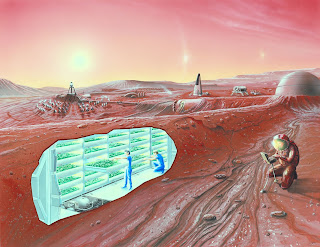The coming age of space colonization…the EmDrive system
The
coming age of space colonization…the EmDrive system
By E. Stanley Ukeni
In a
recent novel by Journalist Julian Guthrie, the famed British cosmologist Stephen
Hawking once again espoused his deeply held conviction that the future survival
of the human race lies in the exploration and colonization of space. Professor
Hawking has consistently advocated the importance of space exploration as a
mean of ensuring the survival of humanity, far into the future.
For
those of us unfamiliar with Professor Stephan Hawking, he is a world renowned
theoretical physicist who has long suffered from a rare early-onset of
slow-progressing form of Amyotrophic Lateral Sclerosis (ALS) that has left him
paralyzed—leaving him only able to communicate using a single cheek muscle
attached to a speech-generating computer device attached to his wheelchair.
In the
book by Julian Guthrie, the Oxford born scientist writes, “I believe that life
on Earth is at an ever-increasing risk of being wiped out by a disaster, such
as a sudden nuclear war, a genetically engineered virus or other dangers…”
He
continues, “I think the human race has no future if it doesn’t go to space.”
He
further advised, “We need to inspire the next generation to become engaged in space
and in science in general, to ask questions. What will we find when we go to
space? Is there alien life or are we alone? What will a sunset on Mars look
like…”
In
fact, in 2013, the seventy-one year-old Stephen Hawking notably declared, at a
lecture in Los Angeles that, ‘it is unlikely that humanity would survive
another one thousand years without spreading out beyond the confines of our
fragile planet’. This was just one of the numerous times that the renowned
theoretical physicist had postulated that, some sort of cataclysmic disaster,
either natural or manmade, will cause the annihilation of all life on earth if humanity does not
fan-out across the universe.
These
may sound like a gloomed outlook of the future of humanity, but I for one think
it’s more of a forward-thinking view of a possible challenge and solution to
humankind’s proven inability to foreseeing an unintended consequence of its
insatiable desire for dominion, and greed.
I recently
attempted to initiate a conversation with this dude, who I met at a coffee
shop, about how appalled I was at Africa’s limited role in advancing the
current effort at space exploration. He was an articulate, seemingly upper
middle-class African in his mid to late thirties, so I thought he would at
least offer a meaningful insight on the subject.
I was
so wrong to think that. He was so averse to the notion of expending any amount
of resources to find habitable planets for human colonization, when as he puts
it, ‘the world has not solved the problem of hunger’. He was so adamant and
uninterested in a contrary opinion or point of view that we could not even have
a meaningful conversation on the topic.
At the
time, I felt it was such a shame that some of us are so closed-minded that we
would not even consider entertaining any idea that challenges our cherished
notions—even if such an opinion has some merit for consideration. I have to
admit that it was an eye-opener to encounter one of the unyielding contrarians
who are of the school of thought that humanity should waste the finite
resources of our planet on the fools-errand of space exploration.
My attempt
at a conversation with this naysayer got me thinking about the practicality of
human exploration of deep space. The issue of how to source fuel for a return
trip to a distant planet engaged my imagination for a period. I figured that
without a viable and practical solution to this problem, I might as well ascribe
to the worldview that my coffee shop acquaintance espoused. It was while I was musing about this issue
that I came across an article about a new experimental technology that held a
promise of solving this conundrum of practical manned-deep space exploration.
The technology
is a controversial EmDrive Space Propulsion System which incidentally, the
United States Air Force and the China Academy of Space technology are presently
testing hybrid versions of the revolutionary technology. Imagine, this futuristic
space propulsion engine, when eventually actualized, holds the promise of
powering a manned-space mission to Mars and back in a matter of weeks. This once
science-fiction idea is close to becoming science-fact
A Radio
Frequency (RF) Resonant Cavity Thruster, equally known as an EmDrive is a
controversial type of Electromagnetic Thruster where an
anisotropicelectromagnetic field inside the microwave cavity purportedly
produces measurable thrust.
The EmDrive
was invented by a British scientist, Roger Shawyer in 2001. His invention,
called EmDrive, is a design with a conical cavity that is based on the theory
of special relativity. His model works by converting electricity into
microwaves and then fired within a truncated cone-shaped closed metal cavity, causing
the microwave particles to exert more force on the flat surface at the large
end of the cone thereby generating thrust. Guido Fetta later invented the
Cannae Drive—with a pillbox-shaped cavity. However, since 2008, a number of
physicists have tested their own models of the Radio Frequency (RF) Resonant
Cavity Thruster.
Critics
of this unorthodox technology have argued that, a reactionless drive, which
does not expel propellant in order to produce thrust, would violate Newton’s
Third law of conservation of momentum and as such impossible under known
scientific norms—thus labeling the hypothesis pseudoscience. However, Shawyer
counters this assertion by insisting that his invention conforms to the fundamental
laws of physics involving the theory of special relativity. Indeed, all the
scientists who are working on similar technology maintain that Radio Frequency
(RF) Resonant Cavity Thruster does in fact conform to the law of conservation
of momentum.
Since 2014,
a team at NASA known as the Advanced Propulsion Physics Laboratory or
Eagleworks Laboratories, began testing Resonant Cavity Thrusters of their own
design, and have been sharing some of their results with the broader scientific
community. In November of 2016, they published their first peer-reviewed paper
on this work, in the Journal of Propulsion and Power— https://arc.aiaa.org/doi/10.2514/1.B36120
Even as
NASA announced, in February 22, 2017, of the discovery of seven, mostly
Earth-size Exoplanets, in the habitable zone of a single star, called
TRAPPIST-1—all of them with the potential for water on their surface, we should
all be heartened to know that the technology to get us there may be just around
the corner.
In
closing, I would like to hope that, as humanity advances onto the next frontier
of human advancement, Africans would step-up and take on a pioneering role among the emerging deep-spacefarers. It’s important that Africa start a conversation about its
role in this emerging frontier of human endeavor.
Authored
by E. Stanley Ukeni, © 2017. All Rights Reserved. This material and other articles or
stories posted on this blog site may not be reproduced, published, broadcast,
rewritten or redistributed, in whole or in part, without prior expressed
written permission from the author, E. Stanley Ukeni.
You
are invited to follow E. Stanley Ukeni on twitter at; @EzStan . I invite you to
equally follow me on google+
Photo credit: NASA













Comments
Post a Comment